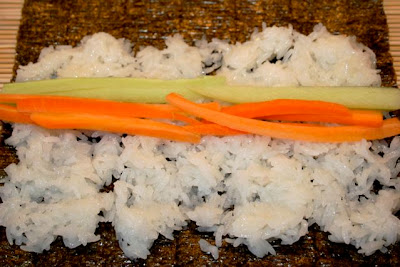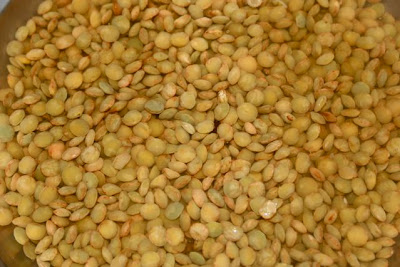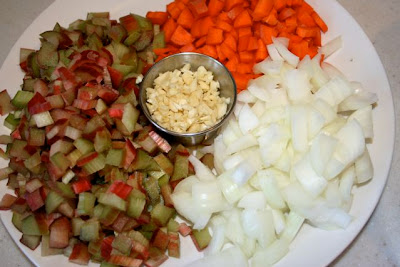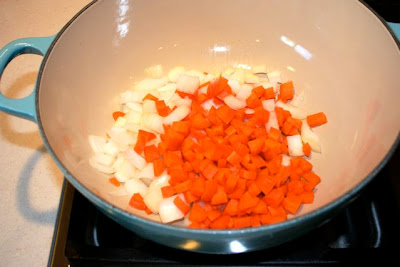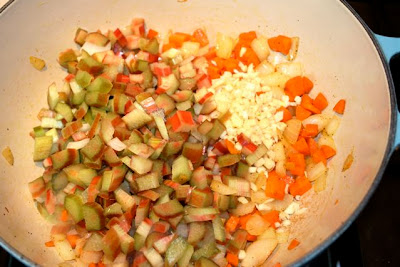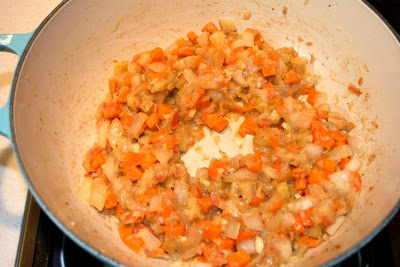 On a cold November day after Thanksgiving, nothing is better than a warm hearty bowl of turkey noodle soup. The roasted turkey carcass was converted into nectar of the gods and the noodles were homemade. Thick, rich and creamy, this was the perfect thing to warm the soul. Not much too it, really. I cooked all the leftover turkey bones and carcass with carrots, celery and onions to make the broth. Strained it off. Peeled whatever meat was left on the bones off and cooked it all together with more fresh vegetables and noodles.
On a cold November day after Thanksgiving, nothing is better than a warm hearty bowl of turkey noodle soup. The roasted turkey carcass was converted into nectar of the gods and the noodles were homemade. Thick, rich and creamy, this was the perfect thing to warm the soul. Not much too it, really. I cooked all the leftover turkey bones and carcass with carrots, celery and onions to make the broth. Strained it off. Peeled whatever meat was left on the bones off and cooked it all together with more fresh vegetables and noodles.
Leftover Turkey Soup
Lamian Noodles, sort of
 Lamian (also called la mien) are hand-pulled Chinese noodles. I have been fascinated with the plethora of youtube videos showing Chinese artisans stretching and pulling these noodles. I so wanted to try this myself. The dough is seemingly simple but if you don’t have the right ratio of gluten in the flour it will never have the right stretchy consistency to pull the noodles no matter how much you knead it. It also needs a pretty high hydration to be pliable enough to stretch. I tried this just using all purpose flour but it was not stretchy enough. I need to get some lower-gluten pastry or cake flour to make these noodles. I resorted to rolling out the dough and cutting the noodles with a knife. They turned out really tasty but I still want to try pulling them some day.
Lamian (also called la mien) are hand-pulled Chinese noodles. I have been fascinated with the plethora of youtube videos showing Chinese artisans stretching and pulling these noodles. I so wanted to try this myself. The dough is seemingly simple but if you don’t have the right ratio of gluten in the flour it will never have the right stretchy consistency to pull the noodles no matter how much you knead it. It also needs a pretty high hydration to be pliable enough to stretch. I tried this just using all purpose flour but it was not stretchy enough. I need to get some lower-gluten pastry or cake flour to make these noodles. I resorted to rolling out the dough and cutting the noodles with a knife. They turned out really tasty but I still want to try pulling them some day.
I made the dough using about 3.5 oz of all purpose flour and 2 oz of water. The dough was kneaded for about 25 minutes the allowed to rest for a few hours. It was kneaded by hand again for 20 or so minutes but it just wouldn’t become stretchy and relaxed enough to pull. It was silky smooth though and made for a great texture in the final product.
I made this soup very simply. I used a Korean beef dashi powder to make a broth and cooked some sliced carrots and celery in the broth for just a few minutes before serving. The noodles were cut and immediately thrown into a pot of salted boiling water. They were cooked for about 3 minutes, strained out and placed into large bowls. The soup was ladelled on top of the noodles. Meanwhile I quickly stir fried some thinly sliced sirloin tip, garlic and a bit of chili sauce. This was placed on top of the soup. It was YUMMY, filling and perfect for a cold winter’s day.
Divine Dining Redux #3 – Creamy smooth gazpacho
 When most people here in the US think of gazpacho, they think of a chunky, tomatoey, thin cold substance that reminds me of bland salsa. However, the authentic dish in Spain is nothing like that. It is creamy, and rich, and delicious. What makes it so? Two things that have been neglected here: bread and olive oil. Let me tell you how gazpacho should be.
When most people here in the US think of gazpacho, they think of a chunky, tomatoey, thin cold substance that reminds me of bland salsa. However, the authentic dish in Spain is nothing like that. It is creamy, and rich, and delicious. What makes it so? Two things that have been neglected here: bread and olive oil. Let me tell you how gazpacho should be.
First, let me give credit where credit is due. I got this recipe from Lynne Rossetto Kasper’s America Public Media radio show, The Splendid Table. It was passed to her by David Rosengarten who was a guest on her show recently. David’s recipe can be found here in its entirety. I doubled his recipe and it was more than enough!
I started with about 4 oz of day old French bread. This was ripped into pieces and soaked with cold water for a couple of minutes. The water was squeezed out. The bread is important as it helps to thicken the soup.
 Next I chopped up about a pound of ripe garden fresh tomatoes, a medium sized sweet onion, about a cup and a half of cucumber (peeled and seeded), a large green bell pepper and a large red bell pepper.
Next I chopped up about a pound of ripe garden fresh tomatoes, a medium sized sweet onion, about a cup and a half of cucumber (peeled and seeded), a large green bell pepper and a large red bell pepper.
 Everything was placed in the blender and 2 tsp of sherry vinegar was added. The mixture was puréed while pouring in 1/2 cup of good extra virgin olive oil. That makes it rich and creamy.
Everything was placed in the blender and 2 tsp of sherry vinegar was added. The mixture was puréed while pouring in 1/2 cup of good extra virgin olive oil. That makes it rich and creamy.
 Once puréed, the mixture was seasoned with salt and pepper and then strained through a seive. The soup was chilled well before serving. I garnished it with more of the basil oil I described in my last post.
Once puréed, the mixture was seasoned with salt and pepper and then strained through a seive. The soup was chilled well before serving. I garnished it with more of the basil oil I described in my last post.
Sushi and more
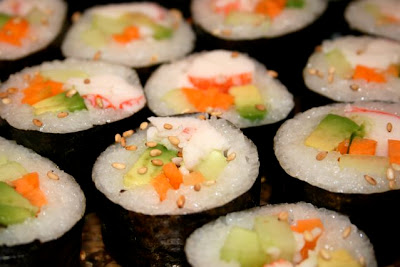 I was in the mood for Japanese cuisine and it’s been a while since I’ve made sushi rolls. They really are not that hard to make and you can put whatever you want inside. These are stuffed with crab, avocado, carrots and cucmbers.
I was in the mood for Japanese cuisine and it’s been a while since I’ve made sushi rolls. They really are not that hard to make and you can put whatever you want inside. These are stuffed with crab, avocado, carrots and cucmbers.
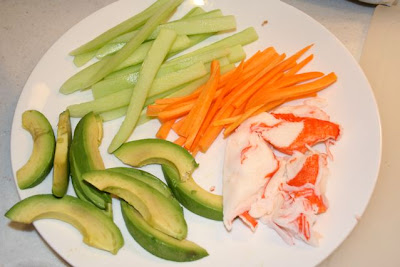 Of course the most important aspect of sushi is the rice. Unfortunately I didn’t have a great sushi rice on hand but at least I had a sticky shorter grain rice. Actually it was too sticky and became a bit gelatinous, but it was ok. Sushi rice preparation is something that is almost an art in Japan. Right out of the steamer, while still hot, the rice is seasoned with rice vinegar usually sweetened with some sugar. The rice is traditionally cooled by fanning by hand. I like to lay out a thin layer of rice about 3/4 of the way up a sheet of nori. It helps of you wet your hands with some water to prevent the rice from sticking.
Of course the most important aspect of sushi is the rice. Unfortunately I didn’t have a great sushi rice on hand but at least I had a sticky shorter grain rice. Actually it was too sticky and became a bit gelatinous, but it was ok. Sushi rice preparation is something that is almost an art in Japan. Right out of the steamer, while still hot, the rice is seasoned with rice vinegar usually sweetened with some sugar. The rice is traditionally cooled by fanning by hand. I like to lay out a thin layer of rice about 3/4 of the way up a sheet of nori. It helps of you wet your hands with some water to prevent the rice from sticking.
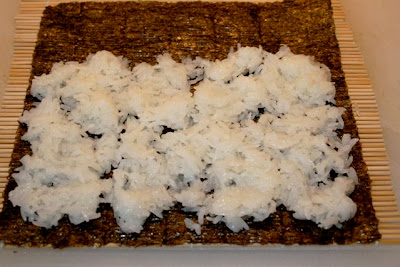 Simply lay your ingredients in the middle of the rice. Here are the cucumbers and carrots.
Simply lay your ingredients in the middle of the rice. Here are the cucumbers and carrots.
 Real sushi chefs can roll these by hand without the aid of a rolling mat, but mine turn out best if I use a mat. The idea is to roll the sushi pulling it in tight to make a firm roll. The edge is sealed by wetting with a little bit of water.
Real sushi chefs can roll these by hand without the aid of a rolling mat, but mine turn out best if I use a mat. The idea is to roll the sushi pulling it in tight to make a firm roll. The edge is sealed by wetting with a little bit of water.
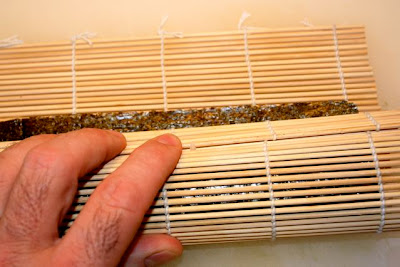 Here is the roll all ready to be sliced.
Here is the roll all ready to be sliced.
 You can slice them however thick you want them. I like a pretty good mouthful myself.
You can slice them however thick you want them. I like a pretty good mouthful myself.
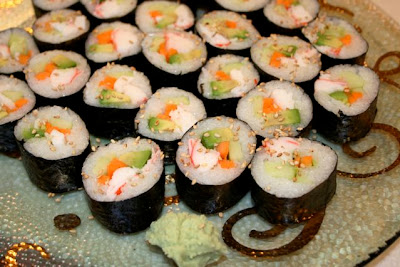 Along with the sushi I made an Asian-inspired soup. I started with a stock pot filled with kombu (seaweed), dried shitake mushrooms, garlic and ginger. This was simmered for about an hour until the mushrooms and seaweed were tender and the broth was flavored.
Along with the sushi I made an Asian-inspired soup. I started with a stock pot filled with kombu (seaweed), dried shitake mushrooms, garlic and ginger. This was simmered for about an hour until the mushrooms and seaweed were tender and the broth was flavored.
 The broth was strained and flavored with some soy sauce, clam dashi powder, a splash of mirin and a dash of sesame oil.
The broth was strained and flavored with some soy sauce, clam dashi powder, a splash of mirin and a dash of sesame oil.
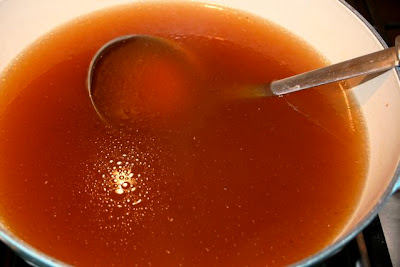 The mushrooms and seaweed were sliced finely and placed back in the soup.
The mushrooms and seaweed were sliced finely and placed back in the soup.
 Served with soy sauce and wasabi, the sushi was really tasty. The soup was very satisfying with a full robust flavor yet lightness that went well with the delicate flavors of the sushi.
Served with soy sauce and wasabi, the sushi was really tasty. The soup was very satisfying with a full robust flavor yet lightness that went well with the delicate flavors of the sushi.

